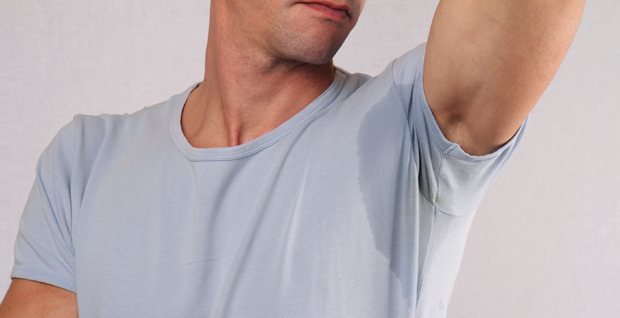Definition:
Hyperhidrosis (hyper-excessive, hidrosis-sweating) is defined as a medical condition in which a person sweats excessively.
Sweating is one of the natural mechanisms to keep body cool. However, when excessive sweating occurs without any trigger, it is called as hyperhidrosis. Such uncontrollable sweating can cause significant discomfort.
Hyperhidrosis can be either primary or secondary
1) Primary hyperhidrosis: When excessive sweating affects the hands, feet, and armpits, without any apparent reason, it is called primary or focal hyperhidrosis.
2) Secondary hyperhidrosis: If the sweating occurs as a result of another medical condition, it is called secondary hyperhidrosis. The sweating may be generalized or focal.
Causes of hyperhidrosis:
- No cause is found in primary hyperhidrosis however, secondary hyperhidrosis may be associated with various medical conditions like
- High environmental temperature
- Drugs and drug poisoning
- Infections
- Cardiovascular, neurologic, endocrine disorders
- Diabetes, Acromegaly
- Anxiety conditions
- Cancer, Carcinoid syndrome
- Near menopause
- Parkinson’s disease
- Spinal cord injury
- Peripheral neuropathy etc.
Signs and symptoms:
The primary symptom of hyperhidrosis is wetness. Secondary maceration of affected area with dirty smelling feet, secondary bacterial or fungal infections causing itching may be seen. Apart from these, affected person may have signs and symptoms of anxiety, depression or psychological stress due to hyperhidrosis. Also symptoms of underlying condition may be present simultaneously e.g. weight loss, palpitations etc in hyperthyroidism.
Investigations:
You may be asked following questions by your treating doctor as a part of examination like location of sweating, time pattern of it, any particular stimulus causing excessive sweating, any other symptoms like weight loss, lack of appetite etc to rule out underlying conditions.
You need to undergo following tests
Tests to diagnose hyperhidrosis
Starch-iodine test. An iodine solution is applied to the sweaty area. After it dries, starch is sprinkled on the area. The starch-iodine combination turns a dark blue color wherever there is excess sweat.
Paper test. Special paper is placed on the affected area to absorb the sweat, and then weighed. The heavier it weights, the more sweat has accumulated.
Tests to rule out underlying condition
Depending on other symptoms and suspected underlying condition, your doctor may advise you some specific tests for that condition e.g. thyroid function tests if hyperthyroidism is suspected.
Complications of hyperhidrosis:
Excessive sweating specially on the palm, soles and underarms may predispose patients to contact dermatitis, pompholyx, fungal infections and bacterial infections like pitted keratolysis.
Apart from this, hyperhidrosis may cause severe psychological disturbance, stress, anxiety and depression in an individual. Some patients may feel social deprivation.
Treatment:
Medical
Topical medicines (Antiperspirants)
Products containing 10% to 20% aluminum chloride hexahydrate are the first line of treatment for underarm sweating. Other products like 2% formaldehyde, 10% glutaraldehyde or 10% tannic acid may be used but aluminum zirconium based products should be avoided.
Antiperspirants can cause skin irritation, and large doses of aluminum chloride can damage clothing. Note: Deodorants do not prevent sweating, but are helpful in reducing body odor.
Oral medicines
Oral anticholinergic drugs like atropine or its analogues, propantheline bromide or calcium channel blockers like diltiazem etc are useful in severe cases.
Sedatives and anxiolytic drugs may be useful in patients having anxiety or psychological disturbance.
Iontophoresis. This procedure uses electricity to temporarily turn off the sweat gland. It is most effective for sweating of the hands and feet. The hands or feet are placed into water, and then a gentle current of electricity is passed through it. The electricity is gradually increased until the patient feels a light tingling sensation. The therapy lasts about 10-20 minutes and requires several sessions. Side effects like skin cracking and blisters, although rare can occur.
For injections on alms and soles nerve block may be used to reduce pain. Its effect last for around six months following single treatment.
Side effects include injection-site pain and flu-like symptoms and sweating of the palms can cause mild, but temporary weakness and intense pain.
Surgical treatment
Excision of small axillary area, suction-assisted lipolysis and surgical curettage of the subcutaneous tissue are used specially for axillary hyperhidrosis.
Sympathectomy (open or thoracoscopic) is a last resort for severe and resistant cases. The procedure turns off the signal that tells the body to sweat excessively. It is usually done on patients whose palms sweat much more heavily.
Adjuvant treatments like behaviour therapy and biofeedback etc may provide some benefit.
Following table summarizes treatment recommendations
Table 1: Summary of treatment choices for primary focal hyperhidrosis
| Type of hyperhidrosis | First line therapy | Second line therapy | Last resort |
| Palmar | Topical therapy, iontophoresis | Botilinum toxin A | Endpscopic thoracic sympathectomy |
| Plantar | Topical therapy, iontophoresis | Botilinum toxin A | Endpscopic thoracic sympathectomy |
| Axillary | Topical therapy, iontophoresis | Botilinum toxin A +/- topical therapy | Local resection, curettage or Endpscopic thoracic sympathectomy |
| Craniofacial | Topical therapy, | Botilinum toxin A | Endpscopic thoracic sympathectomy |
Prognosis:
Secondary sweating may be cured completely if underlying cause is found and treated.
Primary sweating needs regular treatment for long time.



Leave a Comment